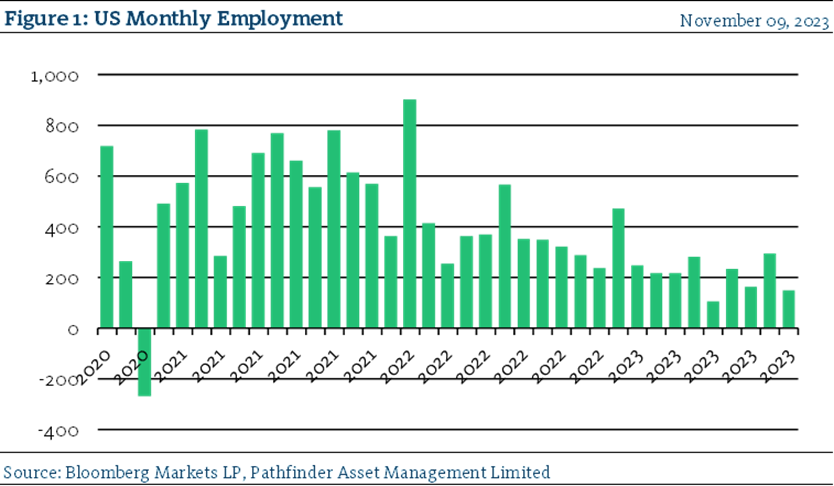Adding Employment Data
Last week, we wrote that manufacturing data and management commentary from consumer companies had caused a change in our thinking. Purchasing Managers Indices (“PMI”) for companies from large economies around the world have deteriorated. We also read commentary from various US consumer companies that indicated that rising borrowing costs “had taken a toll” on the regular US household. We concluded that recent US Central Bank commentary with respect to high interest rates and tightening financial conditions indicated that the global economy is slowing and there was a potential for a soft landing, which would be very good for risk assets.
- After we wrote last week, the US Bureau of Labour and Statistics released its monthly employment The data was weak.
- Only 150k jobs were created. Most came from government and health care, and manufacturing actually fell by 35k jobs.
- For comparison, please see Figure 1, which shows that monthly job creation over the past three years has slowed. The unemployment rate has also increased to 3.9% from a low of 3.4%, set at the end of last year. This is a significant change.

- We also watch the Weekly Jobless Claims data for high frequency feedback on the job market. While initial weekly claims remain stubbornly low, continuing jobless claims rose again for the 7th week in a row. Currently, there are 1.83 million people that remain in the jobless claims system. This has risen from a low of 1.4 in September and suggests that it is harder for those that have recently lost work to find another job again.
“This means that” this data adds further confirmation of our evolving thesis. Interest rates are higher, manufacturing expectations are slowing, consumer companies are indicating that the households are stressed. This week, we note that job market data, from two separate sources, shows the labour market is slowing. We will continue to watch closely, but at the same time welcome the slowing data, which at the margin should help cool inflation. We will pay special attention to central bank comments over the coming months to look for further confirmation and the potential for central bank’s easing to follow.
National Instrument 31-103 requires registered firms to disclose information that a reasonable investor would expect to know, including any material conflicts with the firm or its representatives. Doug Johnson and/or Pathfinder Asset Management Limited are an insider of companies periodically mentioned in this report. Please visit www.paml.ca for full disclosures.
Changes in Leverage. We are increasing the asset ceiling to 2.0 times the market value of equity for Pathfinder International Fund and Pathfinder Real Fund to be consistent with Pathfinder Partners’ Fund and Pathfinder Resource Fund.
*All returns are time weighted and net of investment management fees. Returns from the Pathfinder Partners’ Fund and Partners’ Real Return Plus Fund are presented based on the masters series of each fund. The Pathfinder Core: Equity Portfolio and The Pathfinder Core: High Income Portfolio are live accounts. These are actual accounts owned by the Pathfinder Chairman (Equity) and client (High Income) which contain no legacy positions, cash flows or other Pathfinder investment mandates or products. Monthly inception dates for each fund and portfolio are as follows: Pathfinder Core: Equity Portfolio (January 2011), Pathfinder Core: High Income Portfolio (October 2012) Partners’ Fund (April 2011), Partners’ Real Return Plus Fund (April, 2013), and Partners’ Core Plus Fund (November 2014).
Pathfinder Asset Management Limited (PAML) and its affiliates may collectively beneficially own in excess of 10% of one or more classes of the issued and outstanding equity securities mentioned in this newsletter. This publication is intended only to convey information. It is not to be construed as an investment guide or as an offer or solicitation of an offer to buy or sell any of the securities mentioned in it. The author has taken all usual and reasonable precautions to determine that the information contained in this publication has been obtained from sources believed to be reliable and that the procedures used to summarize and analyze such information are based on approved practices and principles in the investment industry. However, the market forces underlying investment value are subject to sudden and dramatic changes and data availability varies from one moment to the next. Consequently, neither the author nor PAML can make any warranty as to the accuracy or completeness of information, analysis or views contained in this publication or their usefulness or suitability in any particular circumstance. You should not undertake any investment or portfolio assessment or other transaction on the basis of this publication, but should first consult your portfolio manager, who can assess all relevant particulars of any proposed investment or transaction. PAML and the author accept no liability of any kind whatsoever or any damages or losses incurred by you as a result of reliance upon or use of this publication.